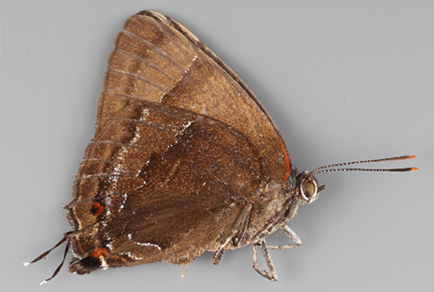Abstract
Male hairstreaks (Theclinae) are often territorial, known for occupying their observation posts at a specific time during the day and at a certain height in the vegetation. The time and height for their perch vary from species to species but remain surprisingly stable year after year in any particular location. From these strategic observation posts males can check the passage of virgin females and chase away competing males. Consequently, these posts act as resources for the males and are not only vigorously defended from conspecific males but also form males of other species. In Peru, males of two closely related species belonging to the genus Thereus Hübner were observed in situ, defending their territories. One of them, Thereus tierralinda Faynel & Fåhraeus, sp. nov., is described here based on five male specimens from Cosñipata valley, Cusco, southern Peru. Further, it is compared to Thereus columbicola (Strand) and other close species in the Thereus eryssus species group. Observations over several years of T. columbicola and this new species show that they have different spatial and temporal characteristics for their perches, presumably to avoid competition with one another. Additionally, as a result of the partial revision of the group, a second new species, Thereus vicens Faynel & Fåhraeus, sp. nov., is also described based on one male and two females from Tingo María, Huánuco, central Peru. We also note that French Guiana is a new country record for Thereus eryssus (Herbst).
References
- Alcock, J. (1987) Leks and hilltopping in insects. Journal of Natural History, 21 (2), 319–328. https://doi.org/10.1080/00222938700771041
- Alcock, J. & Carey, M. (1988) Hilltopping behaviour and mating success of the tarantula hawk wasp, Hemipepsis ustulata (Hymenoptera: Pompilidae), at a high elevation peak. Journal of Natural History, 22 (5), 1173–1178. https://doi.org/10.1080/00222938800770741
- Baughman, J.F., Murphy, D.D. & Ehrlich, P.R. (1988) Population structure in a hilltopping butterfly. Oecologia, 75, 593–600. https://doi.org/10.1007/BF00776425
- Callaghan, C.J. (1983) A study of isolating mechanisms among Neotropical butterflies of the subfamily Riodininae. Journal of Research on the Lepidoptera, 21 (3), 159–176. https://doi.org/10.5962/p.266799
- Comstock, J.H. (1918) The wings of insects. The Comstock Publishing Company, Ithaca. 430 pp.
- Dieckmann, U. & Doebeli, M. (1999) On the origin of species by sympatric speciation. Nature, 400 (6742), 354–357. https://doi.org/10.1038/22521
- Faynel, C. (2003) Cinq années d’observation sur les Theclinae de Guyane française (Lepidoptera: Lycaenidae). Bulletin des Lépidoptéristes Parisiens, Hors-Série, Lépidoptères de Guyane, 49–62.
- Faynel, C. & Bálint, Z. (2004) Supplementary information on neotropical Eumaeini primary type material and further historical specimens deposited in the Muséum national d’Histoire naturelle, Paris (Lycaenidae, Theclinae). Bulletin de la Société Entomologique de France, 109 (3), 263–286. https://doi.org/10.3406/bsef.2004.16126
- Faynel, C. & Moser, A. (2008) The neotropical genus Oenomaus Hübner with the description of eight new species belonging to the atena group (Lepidoptera, Lycaenidae). Lambillionea, 108 (2), Supplément I, 1–36.
- Hewitson, W.C. (1867) Illustrations of Diurnal Lepidoptera. Lycaenidae. Vol. 3. John Van Voorst, London, 102 pp., pl. 46, figs. 203–204.
- McBride, C.S., van Velzen, R. & Larsen, T.B. (2009) Allopatric origin of cryptic butterfly species that were discovered feeding on distinct host plants in sympatry. Molecular Ecology, 18 (17), 3639–3651. https://doi.org/10.1111/j.1365-294X.2009.04309.x
- Nicolay, S.S. & Robbins, R.K. (2005) Five new dry-area South American Strymon species (Lycaenidae: Theclinae) and their biogeographic significance. Journal of Research on the Lepidoptera, 38, 35–49. https://doi.org/10.5962/p.263981
- Painter, K.J. (2014) Multiscale models for movement in oriented environments and their application to hilltopping in butterflies. Theoretical Ecology, 7, 53–75. https://doi.org/10.1007/s12080-013-0198-0
- Prieto, C. & Dahners, H.W. (2006) Eumaeini (Lepidoptera: Lycaenidae) del cerro San Antonio: Dinámica de la riqueza y comportamiento de “Hilltopping”. Revista Colombiana de Entomología, 32 (2), 179–190. https://doi.org/10.25100/socolen.v32i2.9388
- Prieto, C. & Dahners, H.W. (2009) Resource utilization and environmental and spatio-temporal overlap of a hilltopping Lycaenid butterfly community in the Colombian Andes, Journal of Insect Science, 9 (1), 16. https://doi.org/10.1673/031.009.1601
- Ratnasingham, S. & Hebert, P.D.N. (2007) BOLD: The Barcode of Life Data System (www.barcodinglife.org). Molecular ecology Notes, 7, 355–364. https://doi.org/10.1111/j.1471-8286.2007.01678.x
- Robbins, R.K. (1991) Evolution, comparative morphology, and identification of the Eumaeini butterfly genus Rekoa Kaye (Lycaenidae. Theclinae). Smithsonian Contributions to Zoology, 498, 1–64. https://doi.org/10.5479/si.00810282.498
- Robbins, R.K. (2004) Introduction to the Checklist of Eumaeini, Lycaenidae. In: Lamas, G. (Ed.), Checklist of Neotropical Lepidoptera. Part 4A. Hesperoidea-Papilionoidea. In: Heppner, J.B. (Ed.), Atlas of Neotropical Lepidoptera. Scientific Publishers, Gainesville, Florida, pp. xxiv–xxx.
- Robbins, R.K., Heredia, M.D. & Busby, R.C. (2015) Male secondary sexual structures and the systematics of the Thereus oppia species group (Lepidoptera, Lycaenidae, Eumaeini). ZooKeys, 520, 109–130. https://doi.org/10.3897/zookeys.520.10134
- Robbins, R.K., Martins, A.R., Busby, R.C. & Duarte, M. (2012) Loss of male secondary sexual structures in allopatry in the Neotropical butterfly genus Arcas (Lycaenidae: Theclinae: Eumaeini). Insect Systematics & Evolution, 43, 35–65. https://doi.org/10.1163/187631212X626195
- Salazar, J.A. (1996) Sobre la concentración de lepidópteros ropalóceros en la cumbre de un cerro del noroccidente de Caldas, Colombia. SHILAP, 24 (94), 183–195.
- Shields, O. (1967) Hilltopping. An ecological study of summit congregation behavior of butterflies on a southern California hill. Journal of Research on the Lepidoptera, 6, 69–178. https://doi.org/10.5962/p.333400
- Wilson, J. (2012) DNA barcodes for insects. Methods in molecular biology, 858, 17–46. https://doi.org/10.1007/978-1-61779-591-6_3
- Winter, W.D. (2000) Basic techniques for observing and studying moths and butterflies. Memoirs of the Lepidopterists’ Society, 5, 1–444.
- Worthen, W.B. (2018) Confirming the relationship between body size and perch height in tropical odonates (Odonata: Libellulidae): wet-season contrasts and experimental tests. International Journal of Odonatology, 21, 229–239. https://doi.org/10.1080/13887890.2018.1536894


